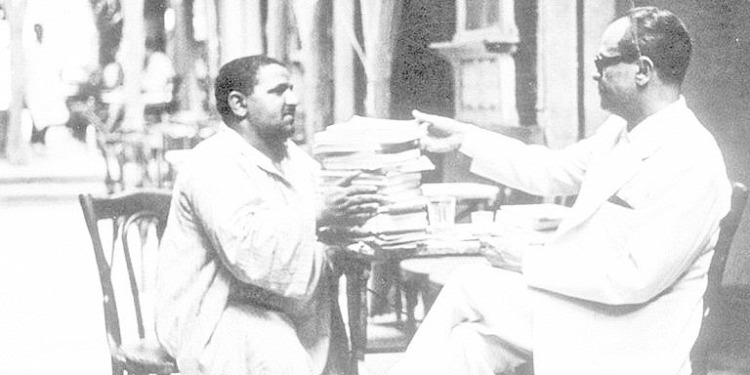A home is not merely a home. It can be a whole neighborhood or a single memory. Its multitudinous nature can be hard to express whether in words or action. Yet, when it comes to the legendary Egyptian author Naguib Mahfouz, the home is the anchor and the integral beating heart of many of his novels.
Raised in El-Gamaleya quarter during the first 10 years of his life, a place bathed and swaddled in Egypt’s rich Islamic history, marked with cobblestone streets, narrow alleyways and antiquated coffee shops. Mahfouz’s love for that district failed to hide in his novels, every corner in the medieval quarter enjoyed a special place in the laureate’s heart. Whether it was the bustling markets of Khan El Khalili or the local on goings of Midaq Alley, these localities were not just representative of the physical spaces of Mahfouz’s childhood, they had a life of their own, as if they were themselves, living breathing characters.
It seems to me that there has to be some link to a specific place, or a specific thing, that is the starting point for one’s feelings and sensations. For me, al-Gamaliya is that place.
Naguib Mahfouz Via Al Ghitani
Zuqaq Al-Midaq, or Midaq Alley
Set during the time of World War II, the book centers around the ongoings of one narrow alley within the El-Gamaleya district, Zuqaq Al-Midaq. One that was traversed many a times by the writer. By taking a turn from Sanadiqiya street, you’ll find yourself in that tight alley that houses a scant few shops including a barber and a bakery. Within that special alley lay the stories of a diverse array of characters.

Yet, if we place a hypothetical lens over Zuqaq Al-Midaq and zoom in a little closer, we’ll notice the major character of the entire book, one that is intrinsically linked to Mahfouz, Kirsha’s coffee shop. Many say that the alley’s coffee shop can be likened to a theater stage, a gathering point for all walks of life from Kirsha, the cafe owner to “the doctor”, the alley’s dentist. It also said that the real life version of that coffee shop is still nestled within its narrow path. Mahouz brings the cafe to life through his excruciatingly detailed description of its interiors:
“It is a square room, somewhat dilapidated. However, in spite of its dinginess, its walls are covered with arabesques. The only things which suggest a past glory are its extreme age and a few couches placed here and there.”
Via Midaq Alley
As Midaq Alley was one of the books written during the 40s, you will notice that Mahfouz’s writing was characterized by high traces of realism, a characteristic style he applied during that time. He gave readers a window into Cairo itself through that alley and its people. It can be said that the alley acted as a microcosm of the entire city of Cairo. As the country was plagued by the war, there was no way to disconnect its effects from of its people. Within that alley, we see traces of the harsh realities brought about by WWII. From the main character reverting to prostitution to the dentist stealing teeth off corpses to make a better living.
Mahfouz managed to condense the struggle of an entire city into a digestible bite sized version represented through the alley, the cafe and its people.
Khan El-Khalili
Again set against the backdrop of World War II, Mahfouz transports his readers to Cairo’s historic and bustling Khan al-Khalili. At that time the city was plagued by consistent streams of bombings. Readers get to take a journey with the Akifs, a middle class family, who make Khan El Khalili’s crowded alleyways, busy cafes and ancient mosques their new home, thinking that by heading to this historic neighborhood they could evade the bombs, yet that was not the case.

We get to see Khan El Khalili through the eyes of the story’s protagonist, Ahmad, the eldest Akif son. Mahfouz pools from his own bank of memories to build his characters whose world is framed by all the different sights and smells that engulfed him through his childhood years.
Mahfouz does so in many ways yet his most impressive technique is when he manages to personify the place itself and make it feel as if it is an actual person. Like for example with his description of Ahmed waking up and looking out at his neighborhood from the window. He described the neighborhood just like he would a person by saying that it started off its day by slowly “stretching out” and slowly getting ready for the day by opening up its shops. Through his realistic descriptions, readers will feel as though they have been teleported to that very window during Cairo’s 1940s.
Whether its Midaq Alley or Khan El Khalili, setting foot at El-Gamaleya will hit different, it will have a different air than the rest of Cairo. Yet, modernization changed its landscape, leaving only some traces of its old spirit. To truly get a realistic taste of the true essence of such a district, reading Mahfouz’s work is the way to go. Each book can be considered a time capsule of that time and its people. That is why the literary legend’s work left a long lasting mark on the Egyptian people and the world beyond it.



